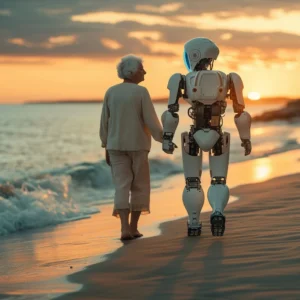
Robotics in elderly care is gaining importance as European populations age, with a notable increase in people aged 65 and older, especially those over 80. This demographic change calls for innovative solutions to enable older adults to live independently at home, despite possible physical and mental challenges. In conjunction with robotics, assistive devices are increasingly vital for preserving the autonomy and well-being of seniors. Technologies like socially assistive robots (SARs) offer social interaction, cognitive engagement, and physical assistance to help close the “care gap” and avoid functional decline. The rising need for elderly care and a lack of trained caregivers highlight the necessity for these technological solutions. Although SARs and assistive devices show potential in improving care for seniors, especially those with cognitive difficulties, issues such as usability, ethical considerations, and personalizing to fit individual needs need to be tackled. Ongoing research and thoughtful implementation are crucial for the success and acceptance of these technologies in elderly care environments.
There is a growing interest in developing human–robot interaction concepts for service robots designed to assist the elderly with physical tasks at home. This area explores how robots and humans can effectively communicate and work together, ultimately enhancing the quality of life for seniors. A particularly intriguing point is that robots are yet to independently and consistently handle all tasks within the complex environments of people’s homes. While fully autonomous robots are not yet available on the market, there is significant potential for providing meaningful support to the elderly in the near future. The domain of artificial intelligence for robotics, which aims to create intelligent machines like robots, is crucial for allowing these robots to perform tasks similar to human activities. As technology progresses, tasks currently managed by remote human operators may increasingly transition to autonomous functions and localized interactions. Ideally, the need for the proposed interaction design would diminish when robots can successfully navigate all conditions independently.

The use of innovation and tech in robotics for elderly care offers numerous applications, particularly with humanoid robots to treat Alzheimer’s and dementia. Research has explored the acceptance of humanoid robots and users’ needs, including those affected by Alzheimer’s disease and related dementias (ADRD), their family caregivers, healthcare professionals, and the broader community. Various studies emphasize the significant potential of social robotics in dementia care and the crucial role of AI and robotics in healthcare solutions.
Care robots are available in various sizes and designs, each customized for particular functions. Some are specifically designed for physical assistance, helping individuals who face challenges in rising, facilitating movement and exercise, monitoring activity levels, detecting falls, and assisting with feeding and bathroom needs.
Service robots for elderly care are intended to assist with daily living activities and enhance seniors’ overall quality of life. These robots can perform household chores, companionship, and health monitoring. Examples include:
Social robots in elderly care focus on delivering emotional support and companionship, using advanced sensors, cameras, and microphones to perceive and respond to human emotions and actions. Examples include:
Assistive technology (AT) has transformed care and autonomy for people facing physical, cognitive, or sensory difficulties. Thanks to advances in robotics for elderly care, the AT sector has seen impressive growth, bringing forth novel solutions that enhance the quality of life for those in need.
For individuals facing mobility challenges, assistive devices play a crucial role in enhancing both independence and mobility. These tools, which range from simple canes to sophisticated powered wheelchairs, empower users to move with greater efficiency and confidence. Here are some examples:
Communication is a vital human necessity, yet it can present challenges for individuals with speech, hearing, or cognitive difficulties. Assistive technology plays a transformative role in bridging these communication gaps. For instance, voice-activated assistants like Amazon Echo and Google Home empower users to manage daily tasks, fostering independence easily. Similarly, speech-generating devices (SGDs) provide a voice for those who find speaking difficult, allowing them to express their thoughts and needs. Moreover, text-to-speech software and hearing aids enhance communication capabilities, enabling individuals to articulate their thoughts and engage socially more effectively.
Simultaneously, smart home technologies have transformed caregiving and daily life for individuals with disabilities by fostering independence. Devices like smart lights and thermostats empower users to independently modify their environments independently, resulting in safer and more comfortable living conditions. Moreover, voice-activated appliances and smart plugs seamlessly combine convenience with reassurance. Automatic pill dispensers and medication reminder applications help individuals manage their health effectively, thus encouraging adherence to treatment regimens. Additionally, wearable fall detection devices and home monitoring systems boost safety by notifying caregivers or emergency services in the event of falls or unusual activities, thereby ensuring prompt assistance.
In conclusion, assistive technology and robotics in elderly care are potent tools that significantly enhance the lives of individuals facing disabilities or health challenges. By integrating these technologies into their daily routines, individuals can experience increased independence, improved safety, and deeper connections with their surroundings. As technology continues to evolve, there will be ever-expanding opportunities to enhance the quality of life for those needing assistance, paving the way for innovative solutions that foster more independent and fulfilling living.
We’re here to help! Whether you have questions, need support, or want to know more about us and our services, fill out the form below and our team will get back to you promptly.
Let’s explore the future of AI and robotics together.
